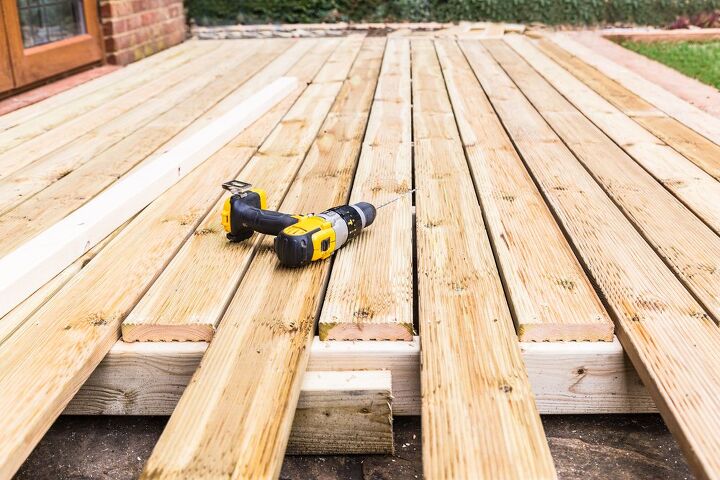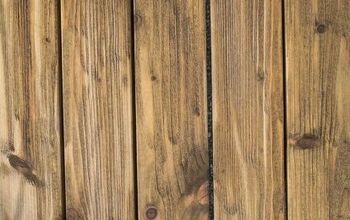Can You Use Non-Pressure Treated Wood For A Deck? (Find Out Now!)

One of the best ways to transform your yard into a comfortable and attractive hangout space is to install a new deck. The size and shape of your deck will depend on your specific yard, but one thing remains true… You’re going to need a lot of wood.
Many people build decks with treated wood. However, you may be wondering if you can use non-pressure treated wood instead. Well, wonder no more!
Yes, you can use non-pressure treated wood to build a deck, but you cannot simply leave it as is. When installing a deck with untreated wood, you will have to seal it properly and either stain or paint it, so it can stand strong against the elements throughout the year.
We’re going to go over what you need to know about building a deck with non-pressure treated wood, so you can enjoy a long-lasting addition to your yard.
Do You Need Deck, Porch, or Gazebo Installers?
Get free, zero-commitment quotes from pro contractors near you.

What is Pressure Treated Wood?
Pressure treated wood is specially cared for to be more durable. There are different types of pressure treatments that can make the wood resistant to decay, mold, water damage, pests, and sometimes even fire.
First the lumber is placed in a pressure chamber with a retort, which is a horizontal steel cylinder. There, a vacuum removes the air from the retort and from the wood itself. After that, treatment chemicals are poured into the cylinder under high pressure. That way, it infuses into the wood.
After this, the treated wood is then moved to a drip pad to cure and dry. This process will usually take about three days, but times can vary depending on exposure to sunlight and the climate.
Pressure Treated Wood vs. Untreated Wood
Treated wood is technically not stronger than untreated wood, but it is more resistant to the elements. Therefore, it will maintain its structural integrity under extreme conditions for a longer period of time.
Basically, this means treated wood will last longer than non-pressure treated wood. Typically, treated wood used for decks can last up to about a decade depending on foot traffic and exposure to the elements. Conversely, untreated wood will most likely last about half that time.
Choosing the Right Untreated Wood
There are plenty of wood species that are best suited for decks even when left untreated. These types of wood will still be rather strong and can stay in good condition for a few years despite environmental impacts. These include:
- Redwood
- Cedar
- White Oak
- African Blackwood
- Sandalwood
Staining vs. Painting
When it comes to building a deck with untreated wood, you’re going to have to make an important decision: to stain or to paint? Both finishing options will protect your deck from inclement weather and moisture. However, they vary drastically in almost every other way, including durability, maintenance, cost, appearance, and application. Let’s take a closer look at these:
Cost
Stain is the more cost-effective option overall, typically ranging from $20 to $35 per gallon. It already contains preservatives to ensure it properly adheres to the deck, which means you won’t need to buy a separate primer either. Since you’ll only have to buy the gallons of stain, you’re looking at a much lower price tag.
When painting a deck, you’re going to have to buy paint, primer, and a wood preservative. A gallon of paint typically costs between $30 and $60. Then, you have to factor in preservatives, land somewhere between $15 and $40 per gallon, and primers, which range from $15 to $30 per gallon.
Customizable Options
As far as style options go, you don’t have much more variety than this. Since wood stains are designed to enhance the natural appearance of the wood, you’ll mostly find clear varieties or shades of brown.
Painting your deck is the better option if you want a wide variety of options for your deck. You can essentially paint your deck any color you want—from neutral hues to vibrant tones. Whatever your style preferences, you’re guaranteed to find the right fit for your space.
Overall Appearance
Stain offers a more natural look since its purpose is to accentuate the look of the wood itself. However, that means it will also showcase any imperfections. This can be a positive or negative depending on the look you want for your deck. If you’re rather disguise those imperfections without going through a paint job, solid wood stain is the way to go. It is more opaque than other options.
As we said before, the appearance of paint on your deck can vary widely, which means you can enjoy a custom look that matches your preferred aesthetic. If you’re searching for a more modern look, painting is the way to go.
Ease of Application
When it comes down to it, applying stain is much easier than painting. Both tasks involve cleaning the surface of the decks, repairing damaged pieces, and sanding the surface. From there, you can apply the stain directly to the surface, and you will only need one coat. Plus, if you get a two-in-one stain and sealer, you won’t even need to apply a top coat.
Painting is a bit different. Before you can apply a layer of paint, you’ll have to treat the deck with a wood preservative and use a primer. At a minimum, you will then need two coats of paint along with a sealer. Since you have to wait for every coat to dry, this will end up taking much longer.
Longevity
Though paint has the potential to chip or peel over time, it tends to last longer than stain. Usually, you won’t need to repaint for 10 years or longer, whereas you’ll most likely need to re-stain every two to four years. That said, there have been some cases of stain lasting closer to eight years.
Maintenance
Paint is easier to maintain over time since it dries smoothly. This makes sweeping much easier than with stain, which penetrates into the wood. Whether you paint or stain, you will have to deep clean at least once a year with a deck cleaner and a soft-bristle brush.
Sealing Your Deck
When using untreated wood, you’re also going to have to seal your deck. This is because untreated wood is very susceptible to water damage. Before you begin staining, make sure the wood is not showing any signs of rotting. Many deck stains will come as a two-in-one mixture that includes a sealant. If you paint, however, you will definitely have to apply a sealant afterwards.
Related Questions
What is the best wood to use for a deck?
Redwood and cedar are the best options for decks because they are both extremely strong. However, they are higher maintenance. Redwood is a bit stronger than cedar, but cedar is less expensive.
How much does it cost to build a deck?
Typically, it can cost anywhere from $4,000 to $11,000 to build a new deck. This translates to about $30 to $60 per square foot.
Do You Need Deck, Porch, or Gazebo Installers?
Get free, zero-commitment quotes from pro contractors near you.

Final Thoughts on Using Non-Pressure Treated Wood for Your Deck
The bottom line is you can build a deck with untreated wood, but it must be prepared properly to ensure it lasts. Even then, it isn’t going to last as long as a pressure treated deck. That said, you can still do it!

I am a copywriter and editor based in the Las Vegas area with nearly a decade of experience under my belt writing landing pages, cost guides, blog posts, newsletters, case studies, and social media content. I have a degree in Strategic Communication and experience working in both the account and creative spheres. My goal is to always be discovering new interests and bettering myself as a writer and editor along the way.
More by Kerry Souder























![10 Most Dangerous Neighborhoods in Baltimore [Updated]](https://cdn-fastly.upgradedhome.com/media/2023/07/31/9075655/10-most-dangerous-neighborhoods-in-baltimore-updated.jpg?size=350x220)



